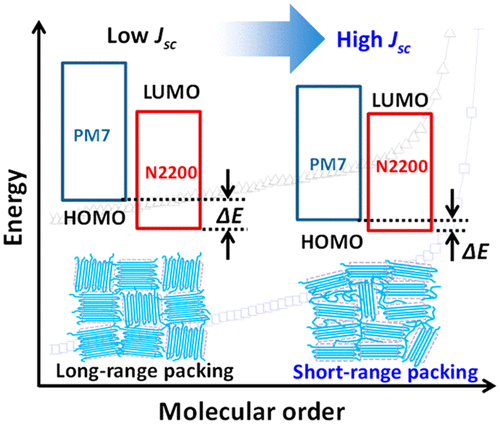当前位置:
X-MOL 学术
›
ACS Energy Lett.
›
论文详情
Our official English website, www.x-mol.net, welcomes your
feedback! (Note: you will need to create a separate account there.)
Molecular and Energetic Order Dominate the Photocurrent Generation Process in Organic Solar Cells with Small Energetic Offsets
ACS Energy Letters ( IF 19.3 ) Pub Date : 2020-01-28 , DOI: 10.1021/acsenergylett.0c00029 Ke Zhou 1 , Yanfeng Liu 2 , Awwad Alotaibi 3 , Jian Yuan 1 , Chuanxiu Jiang 4 , Jingming Xin 1 , Xinfeng Liu 4 , Brian A. Collins 3 , Fengling Zhang 2 , Wei Ma 1
ACS Energy Letters ( IF 19.3 ) Pub Date : 2020-01-28 , DOI: 10.1021/acsenergylett.0c00029 Ke Zhou 1 , Yanfeng Liu 2 , Awwad Alotaibi 3 , Jian Yuan 1 , Chuanxiu Jiang 4 , Jingming Xin 1 , Xinfeng Liu 4 , Brian A. Collins 3 , Fengling Zhang 2 , Wei Ma 1
Affiliation

|
Minimizing the energetic offset between the donor (D) and acceptor (A) in organic solar cells (OSCs) is pivotal for reducing the charge-transfer (CT) loss and improving the open-circuit voltage (Voc). This nevertheless leads to a topic of debate regarding the driving force for the charge separation in OSCs with small energetic offsets. The molecular packing geometries in the active layer determine the energetic levels and trap density, but their relationship with the driving force is seldom considered. Limited by the complicated demixing morphology and inaccurate measurements of energy levels in the prototypical bulk-heterojunction (BHJ) devices, we thereby demonstrate a concise and robust planar-heterojunction model of PM7/N2200 to investigate the origin of driving force for charge generation. It is surprising to note that the device with smaller energy offset shows higher efficiency. Further analysis reveals that a bilayer device with short-range packing PM7 exhibits smaller energetic offsets along with fewer morphological defects and traps compared to its long-range packing counterparts. This molecular packing characteristic diminishes the energetic disorder at the D/A interfaces and inhibits the trap-assisted charge recombination, contributing to the increased short-circuit current (Jsc) and Voc. Our results suggest that the energetic offset actually has limited influence on charge separation, while the synergetic control of molecular and energetic order is vital to the photocurrent generation and energy loss reduction in OSCs.
中文翻译:

分子和能级主导了具有小能量偏移的有机太阳能电池中的光电流产生过程
使有机太阳能电池(OSC)中的施主(D)和受主(A)之间的能量偏移最小化对于减少电荷转移(CT)损失并改善开路电压(V oc)。但是,这引起了关于具有小能量偏移的OSC中电荷分离的驱动力的争论。活性层中的分子堆积几何形状决定了能级和陷阱密度,但很少考虑它们与驱动力的关系。受限于原型体异质结(BHJ)器件中复杂的混合形态和能量水平的不精确测量,因此,我们证明了PM7 / N2200的简洁,鲁棒的平面异质结模型可用于研究产生电荷的驱动力的起源。令人惊讶地注意到,具有较小能量偏移的设备显示出更高的效率。进一步的分析表明,与长距离包装的同类产品相比,具有短距离包装的PM7双层器件显示出较小的高能偏移以及较少的形态缺陷和陷阱。这种分子堆积特性减少了D / A界面上的能量紊乱,并抑制了陷阱辅助的电荷复合,从而增加了短路电流(J sc)和V oc。我们的结果表明,高能偏移实际上对电荷分离的影响有限,而分子和高能顺序的协同控制对于OSC中的光电流产生和能量损失的减少至关重要。
更新日期:2020-01-29
中文翻译:

分子和能级主导了具有小能量偏移的有机太阳能电池中的光电流产生过程
使有机太阳能电池(OSC)中的施主(D)和受主(A)之间的能量偏移最小化对于减少电荷转移(CT)损失并改善开路电压(V oc)。但是,这引起了关于具有小能量偏移的OSC中电荷分离的驱动力的争论。活性层中的分子堆积几何形状决定了能级和陷阱密度,但很少考虑它们与驱动力的关系。受限于原型体异质结(BHJ)器件中复杂的混合形态和能量水平的不精确测量,因此,我们证明了PM7 / N2200的简洁,鲁棒的平面异质结模型可用于研究产生电荷的驱动力的起源。令人惊讶地注意到,具有较小能量偏移的设备显示出更高的效率。进一步的分析表明,与长距离包装的同类产品相比,具有短距离包装的PM7双层器件显示出较小的高能偏移以及较少的形态缺陷和陷阱。这种分子堆积特性减少了D / A界面上的能量紊乱,并抑制了陷阱辅助的电荷复合,从而增加了短路电流(J sc)和V oc。我们的结果表明,高能偏移实际上对电荷分离的影响有限,而分子和高能顺序的协同控制对于OSC中的光电流产生和能量损失的减少至关重要。











































 京公网安备 11010802027423号
京公网安备 11010802027423号